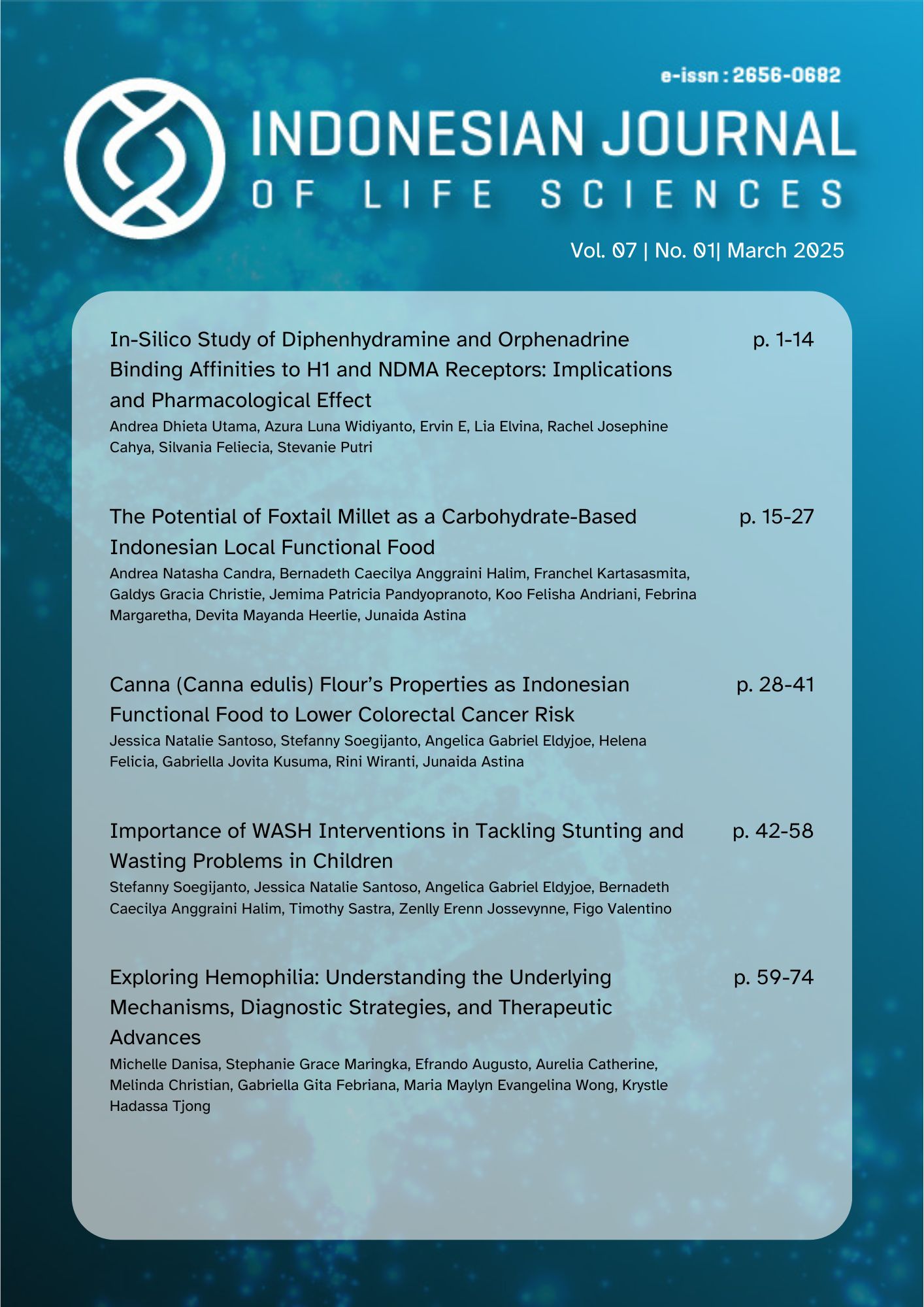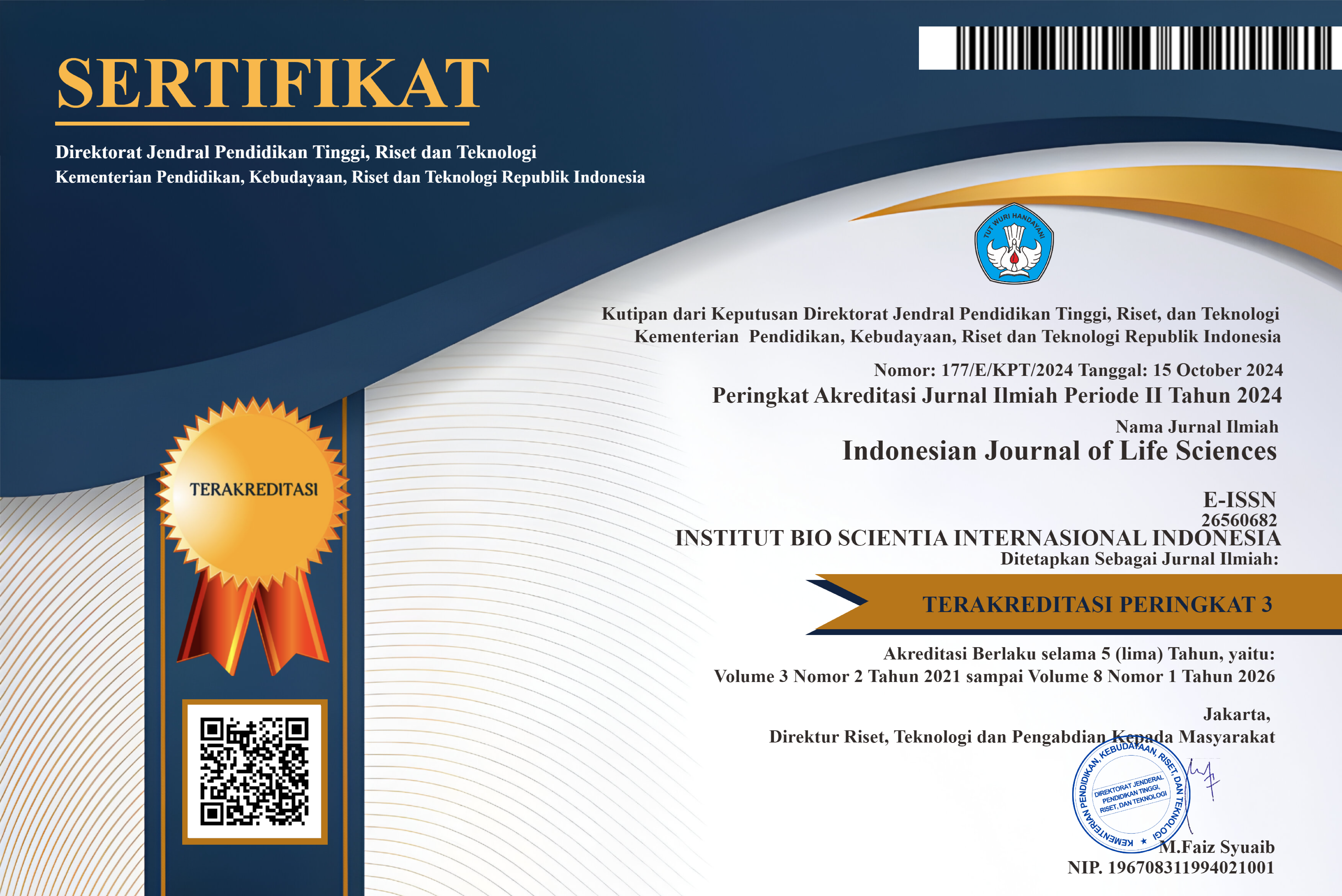The Potential of Foxtail Millet as a Carbohydrate-Based Indonesian Local Functional Food
Abstract
Foxtail millet (Setaria italica L.) is a round-shaped cereal grain varied in colors and sizes and is part of the Poaceae family alongside sorghum and maize. It is one of the most extensively cultivated crops in Asia and Africa, as well as in several other developing countries. In 2014 alone, Asia and Africa produced 95% of the total global foxtail millet yield. Foxtail Millet itself is a good source of bioactive compounds such as minerals, phenolic compounds, amino acids, dietary fibers, carotenoids, sterols, unsaturated fatty acids, phytic acids, tocols, and anti-nutritive compounds. Due to these reasons, foxtail millet has several health benefits such as antioxidant activity, anti-hyperglycemic effects, anti-cholesterol effects, anti-hypertensive effects, and anthropometric effects. It has been mentioned that fox millet contains antioxidants, metal chelators, and reductants in the soluble and insoluble phenolic extracts which are beneficial as natural antioxidant sources. In animals, foxtail millet has also been proven to be safe and its benefit has been proven, specifically in terms of its gastroprotective effect. However, foxtail millet might cause an allergic reaction in humans due to cross-reactivity among different grains. Hence, the safety and efficacy of foxtail millet should be studied further. However, potentially, foxtail millet could be incorporated into a variety of aspects of the food industry. One of the functions is that it can be used to incorporate the flour in order to increase the nutritional properties, such as the mineral and fiber content of the flour itself.
Downloads
References
Akanbi, T. O., Timilsena, Y., & Dhital, S. (2019). Bioactives from millet: Properties and effects of processing on bioavailability. Bioactive Factors and Processing Technology for Cereal Foods, 171–183. https://doi.org/10.1007/978-981-13-6167-8_10
Arora, L., Aggarwal, R., Dhaliwal, I., Gupta, O. P., & Kaushik, P. (2023). Assessment of sensory and nutritional attributes of foxtail millet-based food products. Frontiers in Nutrition, 10. https://doi.org/10.3389/FNUT.2023.1146545
Bilal Sajid Mushtaq, Waleed AL-Ansi, Abhitosh Dhungle, et al. (2021). Influence of pretreatments combined with extrusion on γ-amino butyric acid, nutritional composition and physicochemical properties of foxtail millet (Setaria italica). Journal of Cereal Science, 102, 103359–103359. https://doi.org/10.1016/j.jcs.2021.103359
Bhatt, D., Rasane, P., Singh, J. et al. (2023). Nutritional advantages of barnyard millet and opportunities for its processing as value-added foods. J Food Sci Technol 60, 2748–2760. https://doi.org/10.1007/s13197-022-05602-1
Chauhan, M., Sonawane, S. K., & Arya, S. S. (2018). Nutritional and nutraceutical properties of millets: a review. Clinical Journal of Nutrition and Dietetics, 1(1), 1-10.
Chen, J., Duan, W., Ren, X., Wang, C., Pan, Z., Diao, X., & Shen, Q. (2016). Effect of foxtail millet protein hydrolysates on lowering blood pressure in spontaneously hypertensive rats. European Journal of Nutrition, 56(6), 2129–2138. https://doi.org/10.1007/s00394-016-1252-7
Chen, Y., Zhang, R., Xu, J., & Ren, Q. (2022). Alteration of intestinal microflora by the intake of millet porridge improves gastrointestinal motility. Frontiers in Nutrition, 9. https://doi.org/10.3389/fnut.2022.965687
Chhavi, A., & Sarita, S. (2012). Evaluation of composite millet breads for sensory and nutritional qualities and glycemic response. Malaysian journal of nutrition, 18(1), 89–101.
Corke, H. (2015). Grain: morphology of internal structure. Encyclopedia of Food Grains. 2nd ed. Elsevier, Oxford, 41-49.
Cruzat, V., Rogero, M. M., Keane, K. N., Curi, R., & Newsholme, P. (2018). Glutamine: Metabolism and Immune Function, Supplementation and Clinical Translation. Nutrients, 10(11). https://doi.org/10.3390/NU10111564
Devisetti, R., Yadahally, S. N., & Bhattacharya, S. (2014). Nutrients and antinutrients in foxtail and proso millet milled fractions: Evaluation of their flour functionality. LWT - Food Science and Technology, 59(2), 889–895. https://doi.org/10.1016/j.lwt.2014.07.003
Diao, X., & Jia, G. (2017). Origin and domestication of foxtail millet. Genetics and genomics of Setaria, 61-72.
Gulati, P., Li, A., Holding, D., Santra, D., Zhang, Y., & Rose, D. J. (2017). Heating reduces proso millet protein digestibility via formation of hydrophobic aggregates. Journal of Agricultural and Food Chemistry, 65(9), 1952–1959. https://doi.org/10.1021/acs.jafc.6b05574
Gupta, R. K., Gangoliya, S. S., & Singh, N. K. (2015). Reduction of phytic acid and enhancement of bioavailable micronutrients in food grains. Journal of Food Science and Technology, 52(2), 676. https://doi.org/10.1007/S13197-013-0978-Y
Hariprasanna, K. (2016). Foxtail millet: Nutritional Importance and Cultivation Aspects. Indian Farming, 73(1), 47-49.
He, L., Zhang, B., Wang, X., Li, H., & Han, Y. (2015). Foxtail millet: nutritional and eating quality, and prospects for genetic improvement. Frontiers of Agricultural Science and Engineering, 2(2), 124-133.
Hou, D., Chen, J., Ren, X., Wang, C., Diao, X., Hu, X., Zhang, Y., & Shen, Q. (2018). A whole foxtail millet diet reduces blood pressure in subjects with mild hypertension. Journal of Cereal Science, 84, 13–19. https://doi.org/10.1016/J.JCS.2018.09.003
Hutabarat, D. J. C., & Valerie Aditya Bowie. (2022). Bioactive compounds in foxtail millet (Setaria italica)-extraction, biochemical activity, and health functional: A review. IOP Conference Series: Earth and Environmental Science, 998(1), 012060–012060. https://doi.org/10.1088/1755-1315/998/1/012060
Ji, J., Liu, Y., Ge, Z., Zhang, Y., & Wang, X. (2019). Oleochemical Properties for Different Fractions of Foxtail Millet Bran. Journal of Oleo Science, 68(8), 709–718. https://doi.org/10.5650/JOS.ESS19063
John Calvien Hutabarat, D., & Aditya Bowie, V. (2022). Bioactive compounds in foxtail millet (setaria italica)-extraction, biochemical activity, and Health Functional: A Review. IOP Conference Series: Earth and Environmental Science, 998(1), 012060. https://doi.org/10.1088/1755-1315/998/1/012060
Kheya, S. A., Talukder, S. K., Datta, P., Yeasmin, S., Rashid, Md. H., Hasan, A. K., Anwar, Md. P., Islam, A. K. M. A., & Islam, A. K. M. M. (2023). Millets: The future crops for the tropics - status, challenges and future prospects. Heliyon, 9(11). https://doi.org/10.1016/j.heliyon.2023.e22123
Kola, G., Reddy, P. C. O., Shaik, S., Gunti, M., Palakurthi, R., Talwar, H. S., & Sekhar, A. C. (2020). Variability in seed mineral composition of foxtail millet (Setaria italica l.) landraces and released cultivars. Current Trends in Biotechnology and Pharmacy, 14(3), 239–255. https://doi.org/10.5530/CTBP.2020.3.25
Kotachi, M., Takahagi, S., Ishii, K., Hanaoka, K., Tanaka, A., & Hide, M. (2020). A case of millet allergy that developed into wheat-induced anaphylaxis by cross-reaction between millet and wheat antigens. Allergology International, 69(3), 471–473. https://doi.org/10.1016/j.alit.2019.12.011
Kumar, K. V. P., Dharmaraj, U., Sakhare, S. D., & Inamdar, A. A. (2016). Flour functionality and nutritional characteristics of different roller milled streams of foxtail millet (Setaria italica). LWT, 73, 274-279.
Kumari, S., Singh, B., & Kaur, A. (2023). Influence of malted buckwheat, foxtail and Proso Millet flour incorporation on the physicochemical, protein digestibility and antioxidant properties of gluten-free rice cookies. Food Chemistry Advances, 3, 100557. https://doi.org/10.1016/j.focha.2023.100557
Li, X., Morita, S., Yamada, H., Koga, K., Ota, W., Furuta, T., Yamatsu, A., & Kim, M. (2022). Free Linoleic Acid and Oleic Acid Reduce Fat Digestion and Absorption In Vivo as Potent Pancreatic Lipase Inhibitors Derived from Sesame Meal. Molecules, 27(15). https://doi.org/10.3390/MOLECULES27154910
Lin, H.-C., Sheu, S.-Y., Sheen, L.-Y., Sheu, P.-W., Chiang, W., & Kuo, T.-F. (2020). The gastroprotective effect of the foxtail millet and adlay processing product against stress-induced gastric mucosal lesions in rats. Journal of Traditional and Complementary Medicine, 10(4), 336–344. https://doi.org/10.1016/j.jtcme.2020.01.003
Meherunnahar, Mst., Ahmed, T., Chowdhury, R. S., Miah, M. A., Sridhar, K., Inbaraj, B. S., Hoque, Md. M., & Sharma, M. (2023). Development of novel foxtail millet-based Nutri-rich instant noodles: Chemical and quality characteristics. Foods, 12(4), 819. https://doi.org/10.3390/foods12040819
Mertz, E. T., Hassen, M. M., Cairns-Whittern, C., Kirleis, A. W., Tu, L., & Axtell, J. D. (1984). Pepsin digestibility of proteins in sorghum and other major cereals. Proceedings of the National Academy of Sciences, 81(1), 1–2. https://doi.org/10.1073/pnas.81.1.1
Narayanan, J., Sanjeevi, V., Rohini, U., Trueman, P., & Viswanathan, V. (2016). Postprandial glycaemic response of foxtail millet dosa in comparison to a rice dosa in patients with type 2 diabetes. The Indian Journal of Medical Research, 144(5), 712. https://doi.org/10.4103/IJMR.IJMR_551_15
Nazni, P., & Devi, R. S. (2016). Effect of processing on the characteristics changes in barnyard and foxtail millet.
Niu, X., & Ge, W. (2018). Drought-tolerant plant growth-promoting rhizobacteria associated with foxtail millet in a semi-arid agroecosystem and their potential in alleviating drought stress. Frontiers in Microbiology, 8, 294536.
Nyambe-Silavwe, H., Villa-Rodriguez, J. A., Ifie, I., Holmes, M., Aydin, E., Jensen, J. M., & Williamson, G. (2015). Inhibition of human α-amylase by dietary polyphenols. Journal of Functional Foods, 19, 723–732. https://doi.org/10.1016/j.jff.2015.10.003
Offiah, V., Kontogiorgos, V., & Falade, K. O. (2019). Extrusion processing of raw food materials and by-products: A review. Critical reviews in food science and nutrition, 59(18), 2979-2998.
Passi, P., Kaur, K., Kaur, J., & Kaul, S. (2023). Quality characterization, bread making properties and storage stability of foxtail millet incorporated bread ready-mix. Journal of Stored Products Research, 104, 102208. https://doi.org/10.1016/j.jspr.2023.102208
Pawar, V. D., & Machewad, G. M. (2006). Processing of foxtail millet for improved nutrient availability. Journal of Food Processing and Preservation, 30(3), 269–279. https://doi.org/10.1111/j.1745-4549.2006.00064.x
Rao, D., Bhaskarachary, K., Arlene Christina, G. D., Sudha Devi, G., & Vilas, A. T. (2017). Nutritional and health benefits of millets (p. 112). ICAR_Indian Institute of Millets Research (IIMR).
Ravindran, G. (1992). Seed protein of millets: Amino acid composition, proteinase inhibitors and in-vitro protein digestibility. Food Chemistry, 44(1), 13–17. https://doi.org/10.1016/0308-8146(92)90251-v
Reaz, A. H., Abedin, M. J., Mohammad Abdullah, A. T., Satter, M. A., & Farzana, T. (2023). Physicochemical and structural impact of CMC-hydrocolloids on the development of gluten-free foxtail millet biscuits. Heliyon, 9(6), e17176. https://doi.org/10.1016/J.HELIYON.2023.E17176
Rehman, S. U., Ali, R., Zhang, H., Zafar, M. H., & Wang, M. (2023). Research progress in the role and mechanism of Leucine in regulating animal growth and development. Frontiers in Physiology, 14. https://doi.org/10.3389/FPHYS.2023.1252089
Ren, X., Yin, R., Hou, D., Xue, Y., Zhang, M., Diao, X., Zhang, Y., Wu, J., Hu, J., Hu, X., & Shen, Q. (2018). The Glucose-Lowering Effect of Foxtail Millet in Subjects with Impaired Glucose Tolerance: A Self-Controlled Clinical Trial. Nutrients, 10(10). https://doi.org/10.3390/NU10101509
Ren, X., Wang, L., Chen, Z., Zhang, M., Hou, D., Xue, Y., Diao, X., Liu, R., & Shen, Q. (2022). Foxtail millet supplementation improves glucose metabolism and gut microbiota in rats with high-fat diet/streptozotocin-induced diabetes. Food Science and Human Wellness, 11(1), 119–128. https://doi.org/10.1016/j.fshw.2021.07.013
Sabuz, A. A., Rana, M. R., Ahmed, T., Molla, M. M., Islam, N., Khan, H. H., Chowdhury, G. F., Zhao, Q., & Shen, Q. (2023). Health-Promoting Potential of Millet: A Review. Separations 2023, 10(2), 80. https://doi.org/10.3390/SEPARATIONS10020080
Sachdev, N., Goomer, S., & Singh, L. R. (2021). Foxtail millet: a potential crop to meet future demand scenario for alternative sustainable protein. Journal of the Science of Food and Agriculture, 101(3), 831-842.
Sasi, J. M., Barman, P., & Lata, C. (2023). Nutraceutomics of Foxtail Millet (Setaria italica L.): Insights. Compendium of Crop Genome Designing for Nutraceuticals, 1–15. https://doi.org/10.1007/978-981-19-3627-2_8-1
Shan, S., Li, Z., Newton, I. P., Zhao, C., Li, Z., & Guo, M. (2014). A novel protein extracted from foxtail millet bran displays anti-carcinogenic effects in human colon cancer cells. Toxicology Letters, 227(2), 129–138. https://doi.org/10.1016/j.toxlet.2014.03.008
Sharma, S., Saxena, D. C., & Riar, C. S. (2015). Antioxidant activity, total phenolics, flavonoids and antinutritional characteristics of germinated foxtail millet (Setaria italica). Cogent Food & Agriculture, 1(1). https://doi.org/10.1080/23311932.2015.1081728
Sharma, N., & Niranjan, K. (2018). Foxtail millet: Properties, processing, health benefits, and uses. Food reviews international, 34(4), 329-363.
Sharma, R., & Sharma, S. (2022). Anti-nutrient & bioactive profile, in vitro nutrient digestibility, techno-functionality, molecular and structural interactions of foxtail millet (Setaria italica L.) as influenced by biological processing techniques. Food Chemistry, 368, 130815. https://doi.org/10.1016/j.foodchem.2021.130815
Sharma, R., Nanda, V., & Sharma, S. (2023). Nutri-Cereals. CRC Press.
Shi, J., Shan, S., Zhou, G., Li, H., Song, G., & Yang, D. (2019). Bound polyphenol from foxtail millet bran exhibits an antiproliferative activity in HT-29 cells by reprogramming miR-149-mediated aerobic glycolysis. Journal of Functional Foods, 56, 246–254. https://doi.org/10.1016/j.jff.2019.03.021
Singh, R. K., Muthamilarasan, M., & Prasad, M. (2017). Foxtail Millet: an Introduction. The Foxtail Millet Genome, 1-9.
Singh, V., Lee, G. D., Son, H. W., Amani, S., Baunthiyal, M., & Shin, J. H. (2022). Anti-diabetic prospects of dietary bio-actives of millets and the significance of the gut microbiota: A case of finger millet. Frontiers in Nutrition, 9. https://doi.org/10.3389/FNUT.2022.1056445
Taofiq, O., González-Paramás, A. M., Barreiro, M. F., Ferreira, I. C. F. R., & McPhee, D. J. (2017). Hydroxycinnamic Acids and Their Derivatives: Cosmeceutical Significance, Challenges and Future Perspectives, a Review. Molecules : A Journal of Synthetic Chemistry and Natural Product Chemistry, 22(2). https://doi.org/10.3390/MOLECULES22020281
Yang, T., Ma, S., Liu, J., Sun, B., & Wang, X. (2022). Influences of four processing methods on main nutritional components of foxtail millet: A review. Grain & Oil Science and Technology, 5(3), 156–165. https://doi.org/10.1016/j.gaost.2022.06.005
Yi, C., Qiang, N., Zhu, H., Xiao, Q., & Li, Z. (2022). Extrusion processing: A strategy for improving the functional components, physicochemical properties, and health benefits of whole grains. Food Research International, 160(3), 111681. https://doi.org/10.1016/j.foodres.2022.111681
Yin, S. Y., Kuo, S. M., Chen, Y. R., Tsai, Y. C., Wu, Y. P., & Lin, Y. R. (2019). Genetic Variation of Physicochemical Properties and Digestibility of Foxtail Millet (Setaria italica) Landraces of Taiwan. Molecules, 24(23). https://doi.org/10.3390/MOLECULES24234323
Zhang, B., Rao, X., Zhang, Y., Dai, W., Xu, Y., Zhao, C., Chen, Z., Wang, J., Fan, D., Wang, X., & Wang, S. (2022). Protective effect of foxtail millet protein hydrolysate on ethanol and pyloric ligation-induced gastric ulcers in mice. Antioxidants, 11(12), 2459. https://doi.org/10.3390/antiox11122459

This work is licensed under a Creative Commons Attribution-NonCommercial-ShareAlike 4.0 International License.
Articles published in Indonesian Journal Life of Sciences are licensed under a Creative Commons Attribution-ShareAlike 4.0 International license. You are free to copy, transform, or redistribute articles for any lawful purpose in any medium, provided you give appropriate credit to the original author(s) and Indonesian Journal Life of Sciences, link to the license, indicate if changes were made, and redistribute any derivative work under the same license. Copyright on articles is retained by the respective author(s), without restrictions. A non-exclusive license is granted to Indonesian Journal Life of Sciences to publish the article and identify itself as its original publisher, along with the commercial right to include the article in a hardcopy issue for sale to libraries and individuals. By publishing in Indonesian Journal Life of Sciences, authors grant any third party the right to use their article to the extent provided by the Creative Commons Attribution-ShareAlike 4.0 International license.










